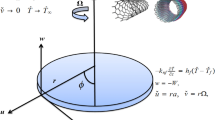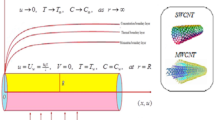Abstract
With an objective to unfold the flow and heat transfer characteristics of carbon nanotubes between two stretchable coaxial rotating disks, the present investigation has been carried out. The behavior of single- and multi-walled carbon nanotubes (SWCNTs and MWCNTs) taking water as the base fluid is analyzed. To formulate the energy equation, we have incorporated Cattaneo–Christov heat flux model. Consideration of such kind of model accounts the contribution by thermal relaxation. von Karman transformation has been implemented in order to reconstruct the governing partial differential equations into a system of ordinary differential equations. Employing optimal homotopy analysis method series solutions are obtained. Error analysis has also been performed and presented in tabular form. The physical clarifications for the behavior of fluid velocity, temperature, skin friction coefficient and Nusselt number are well demonstrated with the help of graphs and contour plots. One of the major outcomes of the present study signifies that water-based SWCNTs have a tendency to cause less drag and higher rate of heat transfer as compared to water-based MWCNTs. This investigation finds numerous applications in different mechanisms of thermal conversion for nuclear propulsion and spacecraft.
















Similar content being viewed by others
References
Choi SUS, Eastman JA. Enhancing thermal conductivity of fluids with nanoparticles. Technical report. Argonne National Lab, IL (United States). 1995.
Eastman JA, Choi SUS, Li S, Yu W, Thompson LJ. Anomalously increased effective thermal conductivities of ethylene glycol-based nanofluids containing copper nanoparticles. Appl Phys Lett. 2001;78:718–20.
Tiwari RK, Das MK. Heat transfer augmentation in a two-sided lid-driven differentially heated square cavity utilizing nanofluids. Int J Heat Mass Transf. 2007;50(9–10):2002–18.
Raei B, Shahraki F, Jamialahmadi M, Peyghambarzadeh SM. Experimental study on the heat transfer and flow properties of-Al2O3/water nanofluid in a double-tube heat exchanger. J Therm Anal Calorim. 2017;127(3):2561–75.
Majka TM, Raftopoulos KN, Pielichowski K. The influence of POSS nanoparticles on selected thermal properties of polyurethane-based hybrids. J Therm Anal Calorim. 2018;133(1):289–301.
Rashidi S, Akar S, Bovand M, Ellahi R. Volume of fluid model to simulate the nanofluid flow and entropy generation in a single slope solar still. Renew Energy. 2018;115:400–10.
Hassan M, Marin M, Ellahi R, Alamri SZ. Exploration of convective heat transfer and flow characteristics synthesis by Cu–Ag/water hybrid-nanofluids. Heat Transf Res. 2018;49(18):1837–48.
Zargartalebi H, Ghalambaz M, Noghrehabadi A, Chamkha AJ. Stagnation-point heat transfer of nanofluids toward stretching sheets with variable thermo-physical properties. Adv Powder Technol. 2015;26(3):819–29.
Ghalambaz M, Doostani A, Izadpanahi E, Chamkha AJ. Phase-change heat transfer in a cavity heated from below: the effect of utilizing single or hybrid nanoparticles as additives. J Taiwan Inst Chem Eng. 2017;72:104–15.
Chamkha AJ, Doostanidezfuli A, Izadpanahi E, Ghalambaz M. Phase-change heat transfer of single/hybrid nanoparticles-enhanced phase-change materials over a heated horizontal cylinder confined in a square cavity. Adv Powder Technol. 2017;28(2):385–97.
Hassan M, Marin M, Alsharif A, Ellahi R. Convective heat transfer flow of nanofluid in a porous medium over wavy surface. Phys Lett A. 2018;382(38):2749–53.
Akbarzadeh M, Rashidi S, Karimi N, Ellahi R. Convection of heat and thermodynamic irreversibilities in two-phase, turbulent nanofluid flows in solar heaters by corrugated absorber plates. Adv Powder Technol. 2018;29(9):2243–54.
Alamri SZ, Ellahi R, Shehzad N, Zeeshan A. Convective radiative plane Poiseuille flow of nanofluid through porous medium with slip: an application of Stefan blowing. J Mol Liq. 2019;273:292–304.
Ellahi R, Zeeshan A, Hussain F, Asadollahi A. Peristaltic blood flow of couple stress fluid suspended with nanoparticles under the influence of chemical reaction and activation energy. Symmetry. 2019;11(2):276.
Yousif MA, Ismael HF, Abbas T, Ellahi R. Numerical study of momentum and heat transfer of MHD Carreau nanofluid over an exponentially stretched plate with internal heat source/sink and radiation. Heat Transf Res. 2019;50(7):649–58.
Majeed A, Zeeshan A, Alamri SZ, Ellahi R. Heat transfer analysis in ferromagnetic viscoelastic fluid flow over a stretching sheet with suction. Neural Comput Appl. 2018;30(6):1947–55.
Sheikholeslami M, Ellahi R, Shafee A, Li Z. Numerical investigation for second law analysis of ferrofluid inside a porous semi annulus: an application of entropy generation and exergy loss. Int J Numer Method Heat Fluid Flow. 2019;29(3):1079–102.
Xue QZ. Model for thermal conductivity of carbon nanotube-based composites. Physica B Condens Matter. 2005;368(1–4):302–7.
Kamali R, Binesh AR. Numerical investigation of heat transfer enhancement using carbon nanotube-based non-Newtonian nanofluids. Int Commun Heat Mass Transf. 2010;37(8):1153–7.
Kumaresan V, Velraj R, Das SK. Convective heat transfer characteristics of secondary refrigerant based CNT nanofluids in a tubular heat exchanger. Int J Refrig. 2012;35(8):2287–96.
Wang J, Zhu J, Zhang X, Chen Y. Heat transfer and pressure drop of nanofluids containing carbon nanotubes in laminar flows. Exp Therm Fluid Sci. 2013;44:716–21.
Khan WA, Khan ZH, Rahi M. Fluid flow and heat transfer of carbon nanotubes along a flat plate with Navier slip boundary. Appl Nanosci. 2014;4(5):633–41.
Ellahi R, Hassan M, Zeeshan A. Study of natural convection MHD nanofluid by means of single and multi-walled carbon nanotubes suspended in a salt-water solution. IEEE Trans Nanotechnol. 2015;14(4):726–34.
Seth GS, Kumar R, Bhattacharyya A. Entropy generation of dissipative flow of carbon nanotubes in rotating frame with Darcy–Forchheimer porous medium: a numerical study. J Mol Liq. 2018;268:637–46.
Fourier J. Theorie Analytique De La Chaleur. Père et Fils: Chez Firmin Didot; 1822.
Cattaneo C. Sulla conduzione del calore. Atti Sem Mat Fis Univ Modena. 1948;3:83–101.
Christov CI. On frame indifferent formulation of the Maxwell–Cattaneo model of finite-speed heat conduction. Mech Res Commun. 2009;36(4):481–6.
Hayat T, Khan MI, Farooq M, Alsaedi A, Waqas M, Yasmeen T. Impact of Cattaneo–Christov heat flux model in flow of variable thermal conductivity fluid over a variable thicked surface. Int J Heat Mass Transf. 2016;99:702–10.
Waqas M, Hayat T, Farooq M, Shehzad SA, Alsaedi A. Cattaneo–Christov heat flux model for flow of variable thermal conductivity generalized Burgers fluid. J Mol Liq. 2016;220:642–8.
Abbasi FM, Shehzad SA. Heat transfer analysis for three-dimensional flow of Maxwell fluid with temperature dependent thermal conductivity: application of Cattaneo-Christov heat flux model. J Mol Liq. 2016;220:848–54.
Hayat T, Khan MI, Farooq M, Yasmeen T, Alsaedi A. Stagnation point flow with Cattaneo–Christov heat flux and homogeneous–heterogeneous reactions. J Mol Liq. 2016;220:49–55.
Karman TV. Uber laminare und turbulente reibung. Z Angew Math Mech. 1921;1(4):233–52.
Cochran WG. The flow due to a rotating disc. In: Mathematical proceedings of the Cambridge philosophical society, vol. 30. Cambridge University Press; 1934. p. 365–75.
Stewartson K. On the flow between two rotating coaxial disks. In: Proceedings of the Cambridge philosophical society, vol. 49. Cambridge University Press; 1953, p. 333–41.
Mellor GL, Chapple PJ, Stokes VK. On the flow between a rotating and a stationary disk. J Fluid Mech. 1968;31(1):95–112.
Arora RC, Stokes VK. On the heat transfer between two rotating disks. Int J Heat Mass Transf. 1972;15(11):2119–32.
Kumar SK, Thacker WI, Watson LT. Magnetohydrodynamic flow between a solid rotating disk and a porous stationary disk. Appl Math Model. 1989;13(8):494–500.
Reddy PS, Sreedevi P, Chamkha AJ. MHD boundary layer flow, heat and mass transfer analysis over a rotating disk through porous medium saturated by Cu-water and Ag-water nanofluid with chemical reaction. Powder Technol. 2017;307:46–55.
Fang T, Zhang J. Flow between two stretchable disks-an exact solution of the Navier–Stokes equations. Int Commun Heat Mass Transf. 2008;35(8):892–5.
Gorder RAV, Sweet E, Vajravelu K. Analytical solutions of a coupled nonlinear system arising in a flow between stretching disks. Appl Math Comput. 2010;216(5):1513–23.
Erfani E, Rashidi MM, Parsa AB. The modified differential transform method for solving off-centered stagnation flow toward a rotating disc. Int J Comput Methods. 2010;7(4):655–70.
Freidoonimehr N, Rostami B, Rashidi MM, Momoniat E. Analytical modelling of three-dimensional squeezing nanofluid flow in a rotating channel on a lower stretching porous wall. Math Probl Eng. 2014;2014, 692728.
Shahmohamadi H, Rashidi MM. VIM solution of squeezing MHD nanofluid flow in a rotating channel with lower stretching porous surface. Adv Powder Technol. 2016;27(1):171–8.
Hussain SM, Jain J, Seth GS, Rashidi MM. Free convective heat transfer with hall effects, heat absorption and chemical reaction over an accelerated moving plate in a rotating system. J Magn Magn Mater. 2017;422:112–23.
Imtiaz M, Hayat T, Alsaedi A, Ahmad B. Convective flow of carbon nanotubes between rotating stretchable disks with thermal radiation effects. Int J Heat Mass Transf. 2016;101:948–57.
Eatemadi A, Daraee H, Karimkhanloo H, Kouhi M, Zarghami N, Akbarzadeh A, Abasi M, Hanifehpour Y, Joo SW. Carbon nanotubes: properties, synthesis, purification, and medical applications. Nanoscale Res Lett. 2014;9(1):393.
Nadeem S, Khan AU, Hussain ST. Model based study of SWCNT and MWCNT thermal conductivities effect on the heat transfer due to the oscillating wall conditions. Int J Hydrogen Energy. 2017;42(48):28945–57.
Hayat T, Qayyum S, Imtiaz M, Alsaedi A. Flow between two stretchable rotating disks with Cattaneo–Christov heat flux model. Results Phys. 2017;7:126–33.
Jyothi K, Reddy PS, Reddy MS. Influence of magnetic field and thermal radiation on convective flow of SWCNTs-water and MWCNTs-water nanofluid between rotating stretchable disks with convective boundary conditions. Powder Technol. 2018;331:326–37.
Mehryan SAM, Kashkooli FM, Ghalambaz M, Chamkha AJ. Free convection of hybrid \({{\rm Al}}_2{\rm O}_3\)-Cu water nanofluid in a differentially heated porous cavity. Adv Powder Technol. 2017;28:2295–305.
Mehryan SAM, Izadpanahi E, Ghalambaz M, Chamkha AJ. Mixed convection flow caused by an oscillating cylinder in a square cavity filled with Cu-\({{\rm Al}}_2{\rm O}_3\)/water hybrid nanofluid. J Therm Anal Calorim. 2019;. https://doi.org/10.1007/s10973-019-08012-2.
Chamkha AJ, Sazegar S, Jamesahar E, Ghalambaz M. Thermal non-equilibrium heat transfer modeling of hybrid nanofluids in a structure composed of the layers of solid and porous media and free nanofluids. Energies. 2019;12(3):541.
Liao S. An optimal homotopy-analysis approach for strongly nonlinear differential equations. Commun Nonlinear Sci Numer Simul. 2010;15(8):2003–16.
Behseresht A, Noghrehabadi A, Ghalambaz M. Natural-convection heat and mass transfer from a vertical cone in porous media filled with nanofluids using the practical ranges of nanofluids thermo-physical properties. Chem Eng Res Des. 2014;92(3):447–52.
Ghalambaz M, Noghrehabadi A, Ghanbarzadeh A. Natural convection of nanofluids over a convectively heated vertical plate embedded in a porous medium. Braz J Chem Eng. 2014;31(2):413–27.
Noghrehabadi A, Saffarian MR, Pourrajab R, Ghalambaz M. Entropy analysis for nanofluid flow over a stretching sheet in the presence of heat generation/absorption and partial slip. J Mech Sci Technol. 2013;27(3):927–37.
Noghrehabadi A, Izadpanahi E, Ghalambaz M. Analyze of fluid flow and heat transfer of nanofluids over a stretching sheet near the extrusion slit. Comput Fluids. 2014;100:227–36.
Acknowledgements
One of the authors Mr. Arnab Bhattacharyya is highly grateful to Indian Institute of Technology (Indian School of Mines), Dhanbad, India, for providing research fellowship to execute this investigation.
Author information
Authors and Affiliations
Corresponding author
Additional information
Publisher's Note
Springer Nature remains neutral with regard to jurisdictional claims in published maps and institutional affiliations.
Rights and permissions
About this article
Cite this article
Bhattacharyya, A., Seth, G.S., Kumar, R. et al. Simulation of Cattaneo–Christov heat flux on the flow of single and multi-walled carbon nanotubes between two stretchable coaxial rotating disks. J Therm Anal Calorim 139, 1655–1670 (2020). https://doi.org/10.1007/s10973-019-08644-4
Received:
Accepted:
Published:
Issue Date:
DOI: https://doi.org/10.1007/s10973-019-08644-4




